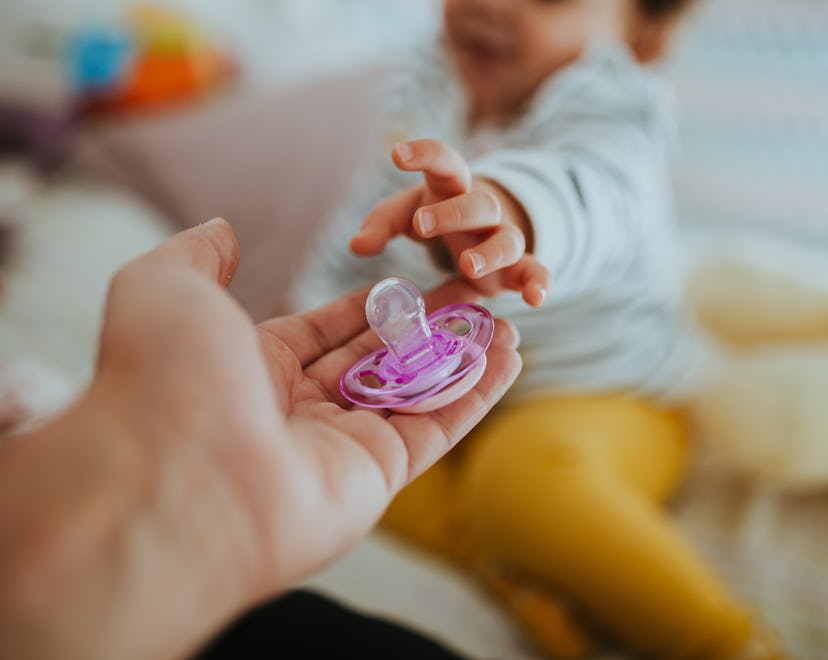Baby

Why Won't My Baby Take A Pacifier? A Pediatrician Explains
It’s so frustrating.
I'd read enough Mommy 101 lit to know better than to let pacifiers do my parenting for me, but what I wasn't expecting was to have the opposite problem. It seemed like everyone else's baby was perfectly content sucking on a pacifier every once in awhile, but not mine. What's the deal? I would constantly wonder in frustration. Why won't my baby take a pacifier?
Why won't my baby take a pacifier?
It turns out, there's more to pacifier magic than simply popping the pacifier in baby’s mouth like a cork and expecting peace. Timing, as they say, is everything.
According to pediatrician Daniel Ganjian, MD, “Pacifier aversion can occur if parents offer the pacifier too frequently and for the wrong cues.” It should really only be used to, well, pacify a baby after all of their other needs have been met. In an exclusive interview with Romper, Ganjian elaborates, “Babies cry for the following reasons: Hunger, tiredness, dirty diaper, colic, wants parental interaction, too hot or cold, or other less frequent reasons. The pacifier should only be used for the tired or colicky child.” If parents offer the pacifier repeatedly at other times, Ganjian says, then the child will take a few sucks and realize that the pacifier has not solved the cause of their unhappiness. “As a result, the baby will learn that the pacifier does not work and will often refuse it. Some might develop an aversion and never take the pacifier again,” Ganjian says.
What to do if your baby won't take a pacifier
If you're sure you've been offering the pacifier at the appropriate times, and your baby still won’t take a pacifier, there are ways to train a newborn to suck a binky, says pediatric speech-language therapist and feeding specialist Melanie Potock, co-author of Raising a Happy Healthy Eater.
When introducing a pacifier, Potock tells Romper, the size and shape matters. Babies might refuse one that is too big or not the correct shape for their mouths. Potock recommends a “pencil” shaped nipple, one uniform narrow tube to allow the sides of the tongue to curl around it. Some babies with low tone will need an orthodontic style nipple, but for most, the pencil is the optimal shape for their developmental needs.
Now you're ready to practice, Potock says. “To encourage new babies to take a pacifier, hold your baby as if you are ready to feed her — tuck her arms into her sides, with her hands in the center of her chest. Tuck up her little knees and allow her feet to rest in the crook of your elbow as you hold her. This flexed position helps babies suck. Push your index finger into the center of the pacifier (in the hole behind the mouth guard), dip the paci into breast milk or formula, and touch baby’s lower lip," she says. Potock claims this will elicit the rooting reflex and your baby will open their mouth. "Gently insert the pacifier and using firm yet gentle pressure, stroke the pacifier down the central groove of baby’s tongue. You’ll see the tongue make a cup as the sides elevate. Pause to give her a chance to hug the pacifier with her tongue and her lips, perhaps sucking a few times."
It may take a few days, Potock says, but practice this method every few hours when baby is slightly drowsy and the odds are good that she'll come around before long. After all, practice makes perfect.
Experts:
Melanie Potock, pediatric speech-language therapist and feeding specialist
Dr. Daniel Ganjian, MD,, pediatrician
This article was originally published on